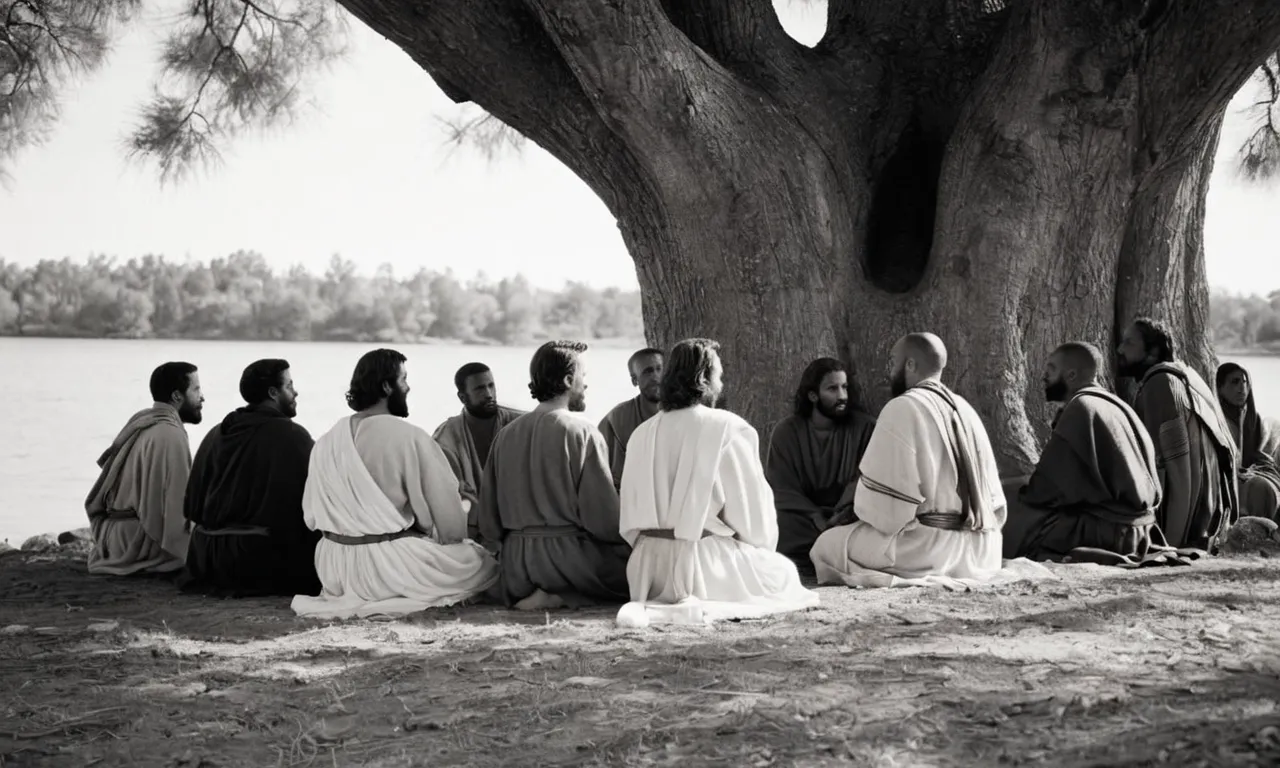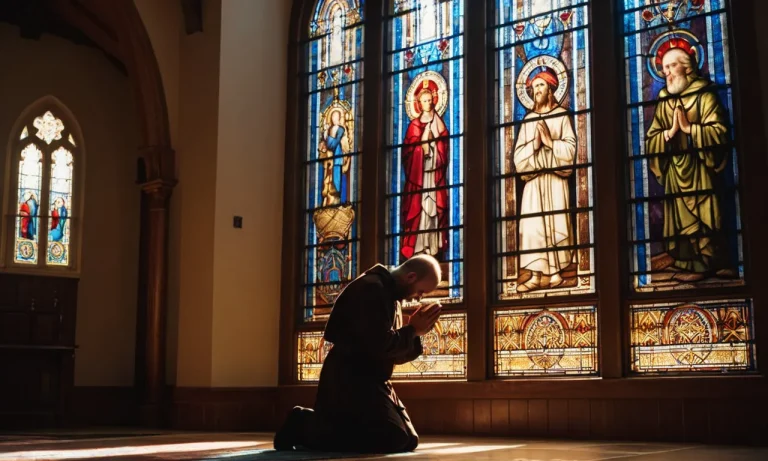Why Did The Disciples Ask Jesus To Teach Them To Prayer?
Prayer is vital for every Christian, yet it can be a mysterious and daunting topic. The disciples themselves, who walked closely with Jesus, recognized their need to grow in understanding prayer. They turned to Christ and simply asked, “Lord, teach us to pray”.
Their humble request can guide us today into a deeper prayer life.
If you’re short on time, here’s a quick answer: The disciples asked Jesus to teach them to pray because they saw the power of His intimate connection with the Father through prayer. They wanted to experience the same depth of communication for themselves.
In this comprehensive article, we will explore the background behind the disciples’ request, Jesus’ example of prayer that motivated them, the specific prayer He taught them, and lessons we can apply to strengthen our own prayer lives even today.
The Disciples Observed Jesus’ Powerful Prayer Life
Jesus Routinely Practiced Lengthy Times of Prayer
Jesus had a strong commitment to spending significant time in prayer, even though He was the perfect Son of God (Mark 1:35). Luke’s Gospel notes that Jesus “often withdrew to lonely places and prayed” (Luke 5:16).
Before major events or decisions, Jesus spent all night in prayer, like before choosing the twelve disciples (Luke 6:12-13) and in the Garden of Gethsemane before His crucifixion (Luke 22:39-46). Through His example, Jesus demonstrated the importance of quality time in prayer to abide in the Father’s presence and seek His will.
Prayer Preceded Major Acts of Ministry in Jesus’ Life
There are several instances recorded in the Gospels where Jesus prayed right before major miracles or events in His ministry. Before the feeding of the 5,000, Jesus lifted up His eyes to heaven, blessed the bread, and broke it (Matthew 14:19).
At the tomb of Lazarus, Jesus prayed out loud to the Father before commanding Lazarus to come forth (John 11:41-43). Even at the transfiguration, Jesus was praying when the glory of God shone around Him and the voice spoke from heaven (Luke 9:29).
His powerful prayers unleashed the power of God at pivotal moments.
Jesus’ Prayers Demonstrated Intimate Connection with the Father
The way Jesus prayed revealed His profound, intimate relationship with the Father. He addressed God directly as “Abba Father” showing His closeness as the Son (Mark 14:36). Jesus’ high priestly prayer in John 17 unveils the depth of love and unity between the Father and Son.
He also demonstrated absolute trust that the Father heard His prayers saying “I knew that You always hear me” (John 11:42). Jesus’ prayer life set an example of depending on the Father through intimate, believing communication.
The Disciples Longed for the Same Depth of Communication
The Disciples Asked Jesus Directly to Teach Them
One day, after observing Jesus praying, the disciples directly approached him, saying “Lord, teach us to pray” (Luke 11:1). They had a deep longing to connect with God the way Jesus did. As they traveled with him, they witnessed the power of his prayers and the intimacy he shared with the Father.
This drove them to desire the same depth of communication for themselves.
They Wanted More Than a Formula, But True Communion
The disciples were not simply asking Jesus for the right words or a prayer formula. They had access to ritual prayers common in Jewish practice. Rather, they longed for authentic fellowship with God. They witnessed how Jesus’ prayers flowed from his relationship with the Father – full of trust, honesty, and love.
The disciples did not just want to repeat words, but to pray from the heart as Jesus did.
Jesus’ prayer life set an example of true divine communion that stirred hunger within his followers. A 2022 Barna study found that 63% of Christians still desire to improve their connection with God through prayer (source).
Like the first disciples, believers today aim for intimacy over religious routine.
Jesus Responded Positively to Their Request
Rather than rebuking his disciples for asking to be taught how to pray, Jesus gave them clear instruction they desired. He first provided what we know as the Lord’s Prayer as a pattern for addressing God and seeking his purposes (Luke 11:2-4). But he did not stop there.
Jesus proceeded to tell a parable contrasting the persistent prayers of a neighbor in need versus common attitudes in approaching God (Luke 11:5-13). He highlighted the benefits of boldly coming to the Father with our requests. The disciples had likely prayed traditional religious prayers many times.
Now Jesus guided them into a relational paradigm of prayer focused on God’s willingness to give good gifts to his children.
The Model Prayer Jesus Taught His Followers
Line-by-Line Analysis of the Lord’s Prayer
In Matthew 6:9-13, Jesus provided his disciples with a model on how to pray. This prayer, commonly called the Lord’s Prayer or Our Father, serves as an outline that covers all the necessary aspects of our relationship and interaction with God. Let’s break it down line-by-line:
- “Our Father in heaven” – We address God intimately as our Father, recognizing his loving care for us as his children. We also acknowledge he is in heaven, meaning he rules over all creation.
- “Hallowed be your name” – We proclaim God’s name as holy, set apart and revered above all else.
- “Your kingdom come, your will be done, on earth as it is in heaven” – We submit to God’s sovereignty and desire for his perfect will to be done everywhere.
- “Give us today our daily bread” – We humbly ask God to supply our practical needs for each day.
- “Forgive us our debts, as we also have forgiven our debtors” – We confess our sins to God and extend the same forgiveness we have received from him to others who have wronged us.
- “Lead us not into temptation, but deliver us from the evil one” – We ask for God’s guidance and protection from the schemes of the devil so we can avoid sin.
Principles for Prayer We Can Draw From This Model
The Lord’s Prayer provides a helpful template for how we can pray in a way that aligns with God’s will and furthers our relationship with him. Here are some key principles we can apply:
- Pray with reverence and intimacy, recognizing God’s fatherly care.
- Exalt God’s name and desire for his will above all else.
- Bring practical requests for our daily needs.
- Seek forgiveness and extend it to others.
- Ask for strength to resist sin and temptation.
This model prayer reminds us that prayer is not a ritual, but rather a way for us to commune with our loving heavenly Father. Through Christ, we can come boldly before God’s throne of grace!
How This Prayer Shapes Our Communing with God
The profound pattern of the Lord’s Prayer has greatly influenced how followers of Christ approach prayer ever since Jesus first taught it. Here are some key ways this model prayer has shaped praying Christians throughout history:
- It grounds prayer in worship by reminding us of God’s supreme holiness and sovereignty.
- It puts priorities in order by focusing first on God’s glory rather than jumping right to our requests.
- It teaches us to pray for God’s will above our own, aligning our desires with his perfect plans.
- It shows us to bring every need and concern to our caring Father, whether large or small.
- It makes confession and extending forgiveness essential aspects of prayer, clearing relational barriers.
- It highlights the importance of praying for strength and deliverance from temptation and evil.
For centuries, reciting the Lord’s Prayer liturgically or using it as a blueprint has helped believers cultivate a rich, biblical prayer life. It steers our communion with God toward praise, submission, petition, confession, and spiritual vigilance.
This model transforms not just our prayers, but our whole relationship with our Father in heaven as we seek to align our hearts with his.
Applying Jesus’ Example to Our Prayer Lives Today
Taking Time for Intimacy with God
Jesus demonstrated the importance of carving out time alone with God through his habit of frequently withdrawing to desolate places for prayer (Luke 5:16). In our fast-paced world, it can be challenging to consistently make space for intimate communion with God.
However, setting aside a designated time each day to read Scripture, meditate, and talk with God is crucial for developing a deep relationship with Him.
This focused time with God realigns our priorities and perspectives, reminding us that He is the source of our purpose and identity. As Dallas Willard said, “Hurry is the great enemy of spiritual life.”
Following Jesus’ example, we must intentionally slow down and create margins in our schedules to be still before God. Whether it’s 30 minutes in the morning, an hour at night, or a few minutes between tasks, regular time alone with God is essential for spiritual health and growth.
Praying for God’s Will Above Our Own
When Jesus prayed in the Garden of Gethsemane before his crucifixion, He submitted to God’s will, saying “not my will, but yours be done” (Luke 22:42). Though Jesus wished for another way, He ultimately chose to obey the Father’s plan.
This models a critical aspect of prayer – humbly surrendering our desires to God.
It’s easy to treat prayer like a wish list, telling God what we want Him to do for us. But prayer is not merely getting God to serve our agenda – it’s aligning our hearts with His purposes. When we pray, we can honestly express our desires, yet release them to God’s perfect will.
As 1 John 5:14 says, prayer involves asking according to His will, not our own. Praying for God’s will over our lives, even when it’s difficult, leads to joy and peace.
Approaching God As a Loving Father
Jesus addressed God using the intimate, affectionate term “Abba”, meaning “Father” (Mark 14:36). This reveals that Jesus had a warm, close relationship with God. He approached God with the trust and simplicity of a child coming to his loving dad.
Jesus’ example shows us that prayer is not a ritual, but a personal conversation with a caring Father.
Too often we come before God feeling ashamed about our failures or distant from Him. But because of Christ, we are completely forgiven and loved unconditionally by God (Romans 8:1). We don’t have to hide our struggles or try to earn God’s approval.
We can come openly and honestly to our Father, knowing He cares for us deeply.
Following Jesus’ model of prayer transforms how we relate to God – from performing religious duty to enjoying intimate friendship with a perfect Father who loves us.
Conclusion
Just as the disciples observed the power of Jesus’ prayer life and longed to share in that same depth of divine communion, we can follow their example today. Approaching Christ in humility and asking Him to teach us, we open ourselves to the blessing of transformation through a vital, thriving conversation with our Heavenly Father.
The model prayer Jesus taught His disciples gives us a pattern for that intimate connection. As we come before God in adoration, submit our wills to Him, depend on Him for provision, open ourselves to His forgiveness, and seek to forgive others, we enter into praying “in His name.” Our lives will surely bear the fruit of abiding in unbroken fellowship with the Lord.








